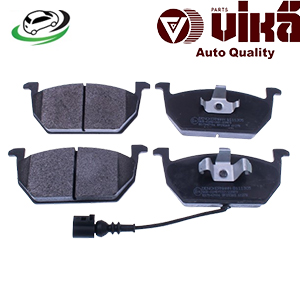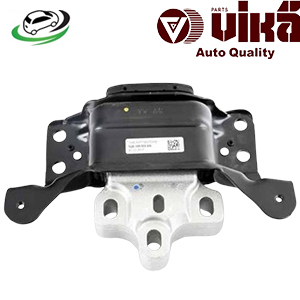-14%
Get AUDI 8V S3 2.0T/ A3 8V 1.8T/ A3 8V TDI/ MK3 TT (2014+) / VW Alltrack 1.8T Gen3/ Golf VII/ Golf VII R Left Transmission Mount 5Q0199555T
The left transmission mount is an essential part of a vehicle’s transmission system, responsible for securing the transmission to the vehicle’s chassis while minimizing vibrations and controlling movement. Though often overlooked, transmission mounts, including the left transmission mount, play a critical role in ensuring smooth transmission operation, proper alignment with the drivetrain, and overall vehicle performance.
In this detailed guide, we will explore the function of the left transmission mount, why it’s important, common problems, and best practices for maintenance to help you understand how this component supports the vehicle’s transmission system.
What is a Transmission Mount?
A transmission mount is a component that secures the transmission to the vehicle’s chassis. Like engine mounts, transmission mounts are designed to absorb vibrations and restrict excessive movement. Most vehicles typically have multiple transmission mounts, including one on the left side of the transmission system. The left transmission mount is specifically positioned to stabilize and secure the transmission in that area, helping to ensure proper functioning.
Transmission mounts usually consist of metal brackets and rubber or hydraulic elements. The metal brackets secure the transmission to the frame, while the rubber or hydraulic material provides flexibility, absorbing vibrations and damping movement caused by engine torque or road conditions.
Function of the Left Transmission Mount
- Transmission Stability: The left transmission mount, like the engine mounts, helps to stabilize the transmission within the engine bay. Its primary role is to hold the transmission in place and prevent excessive movement during driving. When accelerating, decelerating, or shifting gears, the transmission generates forces that, without a mount, could cause it to shift, resulting in misalignment with the drivetrain. The left transmission mount keeps the transmission aligned and secure.
- Vibration Absorption: One of the key functions of transmission mounts is to dampen vibrations produced by the transmission and engine. This is crucial for comfort, as unabsorbed vibrations would otherwise transfer to the chassis and, ultimately, into the vehicle’s cabin, making the ride uncomfortable. The left transmission mount is vital in isolating these vibrations, particularly those generated by the engine and transmission during power delivery and gear shifts.
- Transmission and Drivetrain Alignment: The left transmission mount helps ensure the transmission remains properly aligned with the engine and drivetrain. Any misalignment can cause wear and tear on critical components such as the driveshaft, axles, or clutch, leading to costly repairs and degraded performance. The left transmission mount works alongside other transmission mounts to maintain optimal alignment.
- Controlling Transmission Movement: During acceleration and deceleration, the engine and transmission generate forces that could cause excessive movement if not properly contained. The left transmission mount helps control lateral and rotational movement of the transmission, ensuring it stays securely in place. By doing so, the mount prevents the transmission from damaging surrounding components, such as the exhaust system or engine.
Types of Transmission Mounts
Transmission mounts come in different designs depending on the type of vehicle and performance needs. The three most common types include:
- Rubber Transmission Mounts: These are the most common mounts, composed of metal and rubber components. The rubber provides flexibility and absorbs vibrations while the metal parts provide the necessary strength. These mounts are effective in isolating vibrations but may degrade over time due to exposure to heat, oil, and stress.
- Hydraulic Transmission Mounts: Hydraulic mounts are filled with fluid to provide a higher level of vibration damping than rubber mounts. These are typically used in higher-end vehicles or vehicles that prioritize ride comfort. The fluid helps absorb vibrations more effectively, particularly during hard acceleration or gear shifts.
- Active Transmission Mounts: In some high-performance or luxury vehicles, active transmission mounts are used. These mounts can adjust their damping properties dynamically based on driving conditions. Active mounts are electronically controlled and are designed to provide optimal vibration isolation at all times.
Importance of the Left Transmission Mount
- Vibration Isolation for Comfort: The left transmission mount plays a crucial role in absorbing the vibrations produced by the transmission. A properly functioning mount ensures that these vibrations do not transfer into the cabin, making the ride quieter and more comfortable. When the left transmission mount fails, increased noise and vibration can disrupt the driver and passengers.
- Preventing Transmission Damage: The left transmission mount also helps prevent damage to the transmission and related components by keeping the transmission securely mounted. Without a functioning mount, the transmission could shift or move excessively, leading to damage to the driveshaft, axles, or engine. Over time, this can result in costly repairs.
- Maintaining Transmission Alignment: The left transmission mount, along with other mounts, is vital for maintaining proper transmission alignment with the engine and drivetrain. Misalignment can lead to excessive wear on the transmission, reduced performance, and even catastrophic failure in severe cases. By securing the transmission in place, the mount ensures that power is delivered smoothly from the engine to the wheels.
- Reducing Engine and Transmission Movement: During acceleration and gear shifts, the engine and transmission produce significant torque that could cause movement if not properly restrained. The left transmission mount controls this movement, preventing unnecessary stress on components like the exhaust system, engine, and transmission.
Common Issues with the Left Transmission Mount
Transmission mounts, including the left transmission mount, are subject to wear and tear due to constant exposure to engine vibrations, heat, and the weight of the transmission. Over time, this can cause the mount to deteriorate or fail. Common issues with the left transmission mount include:
- Worn or Cracked Rubber: In rubber mounts, the rubber component can degrade over time due to exposure to heat, oil, and the constant stress of engine movement. As the rubber deteriorates, the mount loses its ability to absorb vibrations, resulting in increased noise and vibrations inside the vehicle.
- Fluid Leaks in Hydraulic Mounts: For hydraulic mounts, fluid leaks can occur, reducing the mount’s ability to absorb vibrations. A leaking mount will cause excessive engine and transmission movement, leading to poor performance and increased wear on surrounding components.
- Loose or Broken Mount: Over time, the bolts securing the left transmission mount can become loose or even break due to the stress of holding the transmission in place. A loose or broken mount can cause the transmission to shift excessively, leading to clunking noises, vibrations, and even misalignment with the drivetrain.
- Increased Engine and Transmission Noise: When the left transmission mount starts to fail, one of the first symptoms you’ll notice is an increase in engine and transmission noise, especially during acceleration or deceleration. This is caused by the transmission moving more than it should, creating excessive vibration and noise.
Symptoms of a Failing Left Transmission Mount
Recognizing the signs of a failing left transmission mount can help you address issues before they become more severe. Common symptoms include:
- Increased Vibrations: One of the most noticeable symptoms of a failing left transmission mount is increased vibrations felt throughout the vehicle, particularly when the vehicle is idling or during gear shifts. This can make the ride uncomfortable and is a clear indicator that the mount may be worn or damaged.
- Clunking or Banging Noises: A failing left transmission mount can cause the transmission to shift during acceleration, deceleration, or while changing gears. This movement may result in clunking or banging noises as the transmission makes contact with other parts of the vehicle, such as the chassis or exhaust.
- Misaligned Transmission: A worn or broken left transmission mount can cause the transmission to become misaligned with the engine and drivetrain. This can result in poor gear engagement, difficulty shifting gears, or even slipping gears.
- Excessive Transmission Movement: If the left transmission mount is damaged, you may notice the transmission shifting or moving more than usual when driving. This can often be felt as a delay in power delivery, particularly during acceleration.
Maintenance and Replacement of the Left Transmission Mount
To ensure your left transmission mount lasts as long as possible and functions effectively, consider these maintenance tips:
- Regular Inspections: Periodically inspect the transmission mounts for signs of wear, such as cracks in the rubber or fluid leaks in hydraulic mounts. Pay particular attention to the left transmission mount, especially in vehicles where the transmission is under significant stress.
- Check Mount Tightness: Ensure that the bolts securing the mount are tight and not loose. Loose bolts can cause the mount to shift, leading to misalignment and excessive wear.
- Replace Worn Mounts: If you notice any of the symptoms of a failing left transmission mount, such as increased vibrations or clunking noises, it’s best to replace the mount as soon as possible. Replacing a worn transmission mount can prevent further damage to the transmission and other components.
- Smooth Driving: Avoid aggressive driving habits such as rapid acceleration, sudden stops, or hard gear shifts. These can put additional stress on the transmission mounts and cause them to wear out faster.
Conclusion
The left transmission mount is a crucial component in a vehicle’s drivetrain system. It ensures that the transmission remains stable and properly aligned while reducing vibrations for a smoother ride. Maintaining a healthy left transmission mount is essential to avoid misalignment, excessive vibrations, and costly repairs. Regular inspection and timely replacement when needed will keep the transmission and overall vehicle performance optimal.
Follow us on Facebook for more parts.




Reviews
Clear filtersThere are no reviews yet.